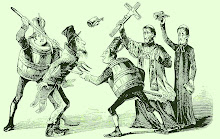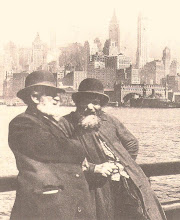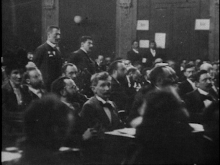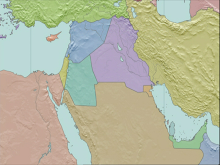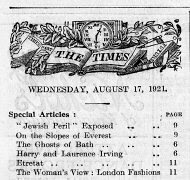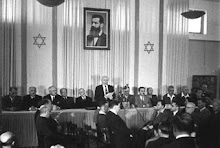The world’s best-known teller of Parables is Jesus Christ, and several of these ‘symbolic stories with hidden meanings’ that He linked together could have profound implications for The Signpost Years.
The three parables of interest all involve the symbol of a fig tree, and the last two, recounted only hours apart and under unusual circumstances, were a major part of Jesus’ final week of ministry before the events of the cross.
Parables can be spoken, acted-out like a drama, or even involve the miraculous as means of illustrating and impressing an important truth. The technique is used to facilitate memory and learning, further contemplation and deepen insight. Importantly, the symbols in a parable stand for, or substitute for, a key ‘something else’ that is actually tangible and substantial in reality. Jesus’ parables most frequently keyed of themes associated with the Kingdom of Heaven.(1)
THE FIRST FIG TREE PARABLE: is a short story Jesus told in the autumn of AD 30, just six months before His crucifixion.
‘A man owns a garden where a fig tree is planted but which, after three years, has produced no fruit. He goes to his gardener and recommends the tree be cut down, it is using up the ground. But the gardener suggests a further short period of special attention to the tree, to compost and support it, and if within a year fruit is still un-forthcoming, it should be removed.’
Jesus’ parables are a bit like Daniel’s mysterious numbers and symbols from which Clarke and Guinness derived the Signpost Years; both Biblical accountants use a form of algebra, substituting symbols for real things that are their equivalent. For example, in this first parable, Jesus uses the fig tree specifically as a symbol representing the people of Israel at that time. The same symbol of the nation was used in their own old testament Bible, so they would understand His parable refers to them.(2)
And Jesus had actually, by then, ministered to the people for three years, but they have produced no spiritual fruit and were in danger of being up-rooted as a consequence. Now, only a little more time and special attention will be given – by Jesus Himself as the gardener in the parable.
In the following springtime, six months later, and on the Monday morning of His last week of ministry to Israel before the crucifixion on Friday, Jesus delivers the second, linked, fig tree parable. The verbal story-telling method is replaced by an even more reinforcing technique.
THE SECOND FIG TREE PARABLE: Enacting the story for special impact.
‘Early Monday, approaching Jerusalem and its Temple to teach there, Jesus spots a fig tree along the road and feeling hungry approaches it to see if there is any fruit on it. But the tree is barren with leaves only. He rebukes the tree severely, stating that it should never be the bearer of fruit again. Some of His followers appear to notice a subtle but immediate change at the tree base, though it is really on the next day, Tuesday morning, following the same walk to Jerusalem, that they see the tree has completely withered away, upwards from its roots.’ (3)
The enactment of this parable is remarkable in several ways. It involves a ‘deconstructive miracle’, in a gesture and effect unlike anything His followers had ever seen before. Even under serious threat and personal attack, Jesus never struck back, responded with a negative outburst, or used power in a harmful negative way, yet alone in a context that was apparently unjustified; He knew too well it was not even the time of year for figs, and the Bible suggests that also.(4) Had He lost His mind?
The two events, Monday and Tuesday, with His uncharacteristic behaviour, must have burned itself into the memory of His disciples like a firebrand. And many would also recall His account in the first fig tree parable, just six months earlier, foretelling Israel’s precarious and impending fate should it not fruit spiritually in the near future.(1) The Jewish religious leaders must have understood the fig tree parable stood for themselves since we are told they grasped the same meaning from a closely similar parable Jesus gave at about the same time: It concerned an unproductive vineyard, its unfaithful and murderous tenants, and their eventual punishment.(5)
THE THIRD FIG TREE PARABLE: End time prophecy and a prophetic command.
But on Tuesday evening, sat on a hill above Jerusalem with a few of His followers, Jesus has one more fig tree parable to tell in the series (following a detailed end time prophecy) and He delivers it with maximum effect, that is while memories of the withered fig tree are still very much in their minds from earlier that same day. Notice how He includes both Jewish and Gentile components throughout:
He prophesies that the Jerusalem Temple will be destroyed by a nation who will build a barrier around the city and besiege its citizens. Its army will decimate the Jews, putting many to the sword, taking the rest captive as slaves to serve among other foreign nations. (This occurred in AD 70). There His believing followers will be dragged before the Kings and rulers of those gentiles. Meantime, bereft of the Jews who will be thus scattered worldwide, other nation states will appropriate and rule Jerusalem and the holy Land, in succession over many years. But critically, at a time when the world’s nations will be in distress and perplexity, and with kingdom fighting kingdom and wars continually rumoured, the gentile nations holding Jerusalem will suddenly relinquish their domineering control, and Jerusalem’s centuries-long ‘trampling underfoot’, prophesied originally by Daniel about 500 BC,(6) will come to an end.
Jesus then encapsulates this prophecy with a further prophetic summary and important hint, as Luke notes:
“And He spoke a parable to them: ‘Watch the fig tree and all the trees. Now when they sprout leaves, seeing it you know the summer is near. So also when you see these things happening, you know that the kingdom of God is near.’ ” (Luke 21:29-31).
[- Jay P., Green (editor and translator): The Interlinear Bible. Hebrew-Greek-English. Hendrickson Publishers. Mass. USA. 1985]
But there are several unusual features about the parable. Firstly, we know that all the symbols stand for something else because it’s a parable. Luke says it is.(7) Hence, what do the separate components ‘fig tree’ and ‘other trees’ stand for?(8) Why single out a fig tree (singular) among the other trees (plural)? And, this word ‘watch’ is quite significant here in the New Testament Greek because it is as a command to do so.(9) Why use this important, demanding and expectant word, if He’s just making a simple ‘comparison’ between budding trees and end time signs?
Most importantly, His follower’s heads are still reeling with Jesus’ uncharacteristic behaviour (10) and its startling consequences upon a fig tree they’d encountered twice within a day, and still only 12 hours ago. And now, He commands them to ‘Watch the fig tree’! Many today are convinced the fig tree is a symbol for national Israel.(11) Some of the reasons may be summarised thus:
a) The fig tree is used as a symbol elsewhere in the bible for Israel.
b) The Gardener and fig tree parable is clearly about Israel in relation to Jesus’ ministry.
c) Jesus’ ministry was about to end that (Passion) week and Israel will reject their messianic King; their spiritual state and its consequences are clearly meant to match that of the now withered fig tree.
d) Jesus’ ‘odd behaviour’ is a parable showing that Israel is about to be cast aside because of its lack of spiritual fruit – exemplified by the withered fig tree, and the fig tree parable warning of this given six months previously.
e) It is unnecessary, and bad methodology, to embellish a parable with superfluous data that might be misconstrued and falsify the semantic intent in the story. Each symbol is intended to have meaning. Jesus need only have said, ‘watch the trees budding’ to make a comparison point, but He specifies a fig tree as a separate component to the other trees, for an integral reason.
f) Jesus matches the parable of the ‘fig tree’ and ‘other trees’ alongside the prophetic timeline of dispersion and Diaspora of the Jews, and then the end times. The prophetic signs He gives are all about Israel and Jerusalem, and the impact of the successive gentile nations upon these throughout.
g) What else could a ‘fig tree and other trees’ symbolise, as real objects, in this parable?
SIGNPOST SIGNIFICANCE
Given that the fig tree is prophetic of Israel’s re-budding(12) in the end time prophecy of Luke 21, as many commentators already hold, the significance for the Signpost Years cannot be overstated: there is only one point in history, since Jesus uttered these words 2,000 years ago, that emphatically and unequivocally satisfies the criteria of national Israel showing signs of its re-budding.
That one epoch was identified clearly by Max Nordau as the period 1901 – 1903 AD precisely. Every effort prior to the achievements then had been surplus and getting the persecuted Jews in the Diaspora no-where, he insists. The turning point, he notes, was the fifth and sixth Congress meetings that saw the Aims and Methods of global Zionism, and the constitutional, economic and commercial machinery to actualise these, collate into existence and momentum for the first time.(13)
If this is the case, then Jesus with Daniel and Clarke are pointing directly, and temporally, to the same monumental turnaround for national Israel as dose Nordau.
But this is not all since Jesus’ prophecy also states that gentile nations, who will ransack Jerusalem and disperse the Jews, will do so only “until” the conclusion of the end time prophecy. The conditional article strongly implys, if not insists, that the Jews will then be back in Sovereign control of their former capital city because, if gentile nations are no longer its governing nationals, who else could be?
Furthermore, the entire prophetic timeline deals with the Gentiles, Jerusalem and Israel’s fate starting in AD 70 and up to the end times. The ending of the Gentile times(14) and “trampling down” in Daniel and Jesus’ words, must have some concluding contingency for Israel, as did its commencement.
Again, if this is the case, then Jesus, with Daniel and Clarke, is pointing to the only time in 2,000 years where this condition of reinstated Jewish ownership of all Jerusalem could have been met, the Signpost Year AD 1967.
For both Signpost Years indicated here in Luke 21, there is now no possibility of some future fulfilment of Jesus’ prophecy because, by nature, a prophetic sign must possess the attribute of being ‘one-off’ or ‘unique’. Otherwise, which instance do we select if there are several, or multiple cases of these, in order to identify significance?
In what way could Israel be said, in the future, to be showing the first signs of re-budding again after long centuries of stasis and Diaspora, or re-gaining Jerusalem as its Capital city for a first time in millennia, when it has blatantly just done so already, at the historically obvious Signpost junctures we have noted?
Each Signpost trajectory has one target only, and each of those located destinations in time were uniquely and hugely significant for Israel and the nations. They cannot be repeated or superseded and fully appear to have satisfied the criteria in Jesus’ prophecy, with Daniel and Clarke, and with recent history.
The Signpost Years alone identify the achievements of the zionist congresses and what they initiated at the turn of the last century, as fulfilling the intention in Jesus’ ‘Watch the fig tree and the other trees’ prophetic command, and the budding of the nation state of Israel - along with Clarke’s derivation of the time of its commencement from Daniel.
And only Clarke’s prospective Signpost Years matches Jesus’ prophetic statement that clearly indicates Israel’s recovery of the city of Jerusalem, ending millennia of gentile tenure there, with Daniel’s target of AD 1967, as a unique and un-missable end time signal to the world, still sounding loud, clear and urgently today.
References:
(1) The Fig Tree and Gardener: Luke 13:6-9
(2) The fig tree is one of the horticultural symbols used of Israel in the Old Testament well before Jesus’ usage, along with the olive tree and grape vine. Trees are also used there as symbols of other nations (- see Jer 11:16, 17 Hos. 9:10, Joel 1:7, Mic 7:1-7 for example).
(3) The Rebuking of the fig tree: Matt 21:19, Mark 11:13
(4) It was not the time of year for figs: Mark 11:13
(5) Vineyard workers and fruit (a parallel parable) – notably the text notes that the Jewish priesthood knew the parable was about them: Mark 12:1-12.
(6) Compare Daniel 8:9 and Luke 21:24, for example.
(7) Luke 21:29 ‘Then He spoke a parable to them…’
(8) Parable (Gk. parabolayn Luke 21:29): A mode of communicating meanings, especially spiritual and in Jesus’ case mostly contingent on teachings associated with the Kingdom of heaven. Everyday items such as fish, coins, sheep, trees, moon and stars, lamps, bread, wine, and so on, are matched symbolically alongside realities of the Kingdom, its requirements, realisation and attainment.
The Budding Fig Tree is ‘a parable’ Luke 21:29 tells us, and must therefore follow the rules of understanding this form of communication, precisely in the fashion we already do when interpreting all the other parables of Jesus: i.e., the symbolic components stand-in for something else that is tangibly associated with the unravelling of Kingdom concerns. Walter Martin, in Kingdom of the Cults (illustrating the existence of eternal judgement in the parable of the Rich Man and Lazarus), points out that Jesus never once used a symbol in any parable that did not have an absolute and real Kingdom analogue.
What else, then, critically in view of the Old Testament parable of Israel as a ‘fig-tree’, the impending fate of Israel in the ‘un-fruiting fig-tree’ parable, and the two parables incorporating the major fig-tree encounters of the previous 34 hours delineating Israel’s unfruitful state, could the parable of the ‘budding fig-tree’ otherwise symbolise?
(9) Having learned the parable from the fig-tree’s behaviour (compare Mark and Matthew’s details), Jesus also includes a directive to ‘watch the fig-tree’: Some translations have expressions matching, ‘Look at the fig tree…’ as if He is merely inviting comparison to a gradual appreciation of developing end time events.
But it has been pointed out that this is not strong enough from the Greek. The linguistic mood is in the Imperative (plural) sense for ‘beholding’ and it is here more of a direct command to all, and one to be maintained, ongoing indefinitely from the context. Jesus is telling us to learn what this parable teaches and keep watching the Fig Tree (national Israel) for its budding as signatory to His end time eschatology.
The internet StudyLight.org New Testament Greek Lexicon (New American Standard Bible) notes the Greek word Idete (Strong’s number 5628) in ‘watch the fig tree’: “The Imperative mood corresponds to the English Imperative, and expresses a command to the hearer to perform a certain action by the order and authority of the one commanding. Thus, Jesus’ phrase, ‘Repent ye, and believe the gospel’ (Mark 1:15) is not an “invitation”, but an absolute command requiring full obedience on the part of all hearers.”
Why would Jesus ‘absolutely command us by order and authority of Himself to obediently compare’ the budding behaviour of trees, simply as a means of comparison to end time signs? Clearly, something more is being commanded.
(see Mark 13:28-37 on the fig tree and the necessity of ‘watchfulness’).
(10) “The first figs ripen in late May or early June. The tree should have had fruit, unripe indeed, but existing…the leaves were a sign that there should have been fruit, unseen from a distance, underneath the leaves. The condemnation of this fig-tree lay in the absence of any sign of fruit.”
- Vines’s Expository Dictionary of New Testament Words. Revised version 1881-1885, under subject ‘Fig Tree’.
(11) Not all commentators see the fig tree as a symbol of Israel, but this is often because they have prior doctrinal predilections, seeing themselves as ‘spiritual Israel’ or suggesting that Israel has no further a part as participants in the unfolding divine plan. They do not easily accommodate what is, to some, a perfectly scriptural and obvious inference.
(12) A common objection that is made asks, ‘if the fig-tree is Israel, what are the other budding trees He tells us to watch?’ But the whole of the Olivet discourse (Luke 21) is about other nations and their unfolding impact on Israel and as signposts of the coming Kingdom. These Gentiles first displace the Jews among the nations, sack Jerusalem and dominate it, then their Kings and rulers persecute Jesus’ followers and even kill some, later the nations are in distress and perplexity at the end time, fighting kingdom against kingdom, while finally they relinquish their tenure over Jerusalem as a cardinal sign of the end.
Jesus is simply saying we must watch for the sign of national Israel budding (the Fig Tree) in relation to the signs He lists, relative to the Gentile nations (the other trees).
(13) See Part 2 of the Signpost Notes for a full account of this view based on the words of Max Nordau form an essay he wrote in London 1905.
(14) ‘The Times of the Gentiles’ (Luke 21:24): The NJB Study Bible Edition (1994) footnote e) acknowledges here that this is ‘the period during which the gentiles will take the place of the unfaithful Jewish nation. Saint Paul notes the period will end, and eventuate in the conversion of that nation (Romans 11). A period, thus, of indeterminate length is introduced (by Jesus) between the ruin of Jerusalem and the end of time.’
This is only partially correct, however, because the gentile displacement of Israel’s Sovereignty had already been ongoing for 500 years since King Nebuchadnezzar (604 BC). That Jesus and His followers understood this truth is evident in a number of places. In Acts 1:6, for example, they ask Him if the moment has come yet for Him to ‘restore the kingdom to Israel’, and which end view Jesus does not question.
NB: The idea held by some that the times of the Gentiles equates to the point in time where ‘the full number of gentile converts have come to faith’ totally misses the whole context of Luke 21; Jesus is talking about the ‘trampling’ of Jerusalem by gentile nations, which actually started under the Kingship of Nebuchadnezzar, was continuing under Rome in Christ’s time, but which succession would have a definitive identifiable end point in the latter days.
© Karl Krysko. 9feb28
Introduction
ONE HUNDRED AND FORTY YEARS BEFORE the actual events came to fruition in the Middle East, two dedicated Bible scholars predicted accurately several key years in the then approaching conflict for tenure of the holy Land and Jerusalem, involving a long prophesised regathering of the Jews to their Promised Land, after nearly 2000 years of Diaspora.
Doctors Clarke and Guinness pointed well in advance to the coming years 1902, 1917, 1947-8 and 1967 AD, having based their predictions on the 2,500 year old Biblical book of Daniel.
Not only did their advance forecasts prove accurate decades later, but those key 'Signpost Years’ continue to mark events and developments in the holy Land, ever since their occurrence in modern times, that now represent the specific themes of serious contention in the struggle for Peace in that region today.
These following NOTES explain the rational behind the Clarke-Guinness thinking in as fast and concise a form as possible, and elaborations will follow. A second critical aim here is not to prove 'The Signpost Years' correct, but rather to use the scientific approach of attempting their falsification first. You can help either way by passing on any objective comments to this site.
PART 1 Is an Introduction and looks at each of the Signpost Years as they were foretold in the writings of Guinness and Clarke. It looks at many of the side issues and has a number of detailed footnotes.
PART 2 Looks at the period 1901 – 1903, and the first of the Signpost Years predicted by Clarke in 1825. This part explains the huge significance of the period and sets the scene for a further link that comes in Part 4.
PART 3 Begins to address some of the typical questions that might arise in the mind of the reader regarding the Signpost Years. Items are added to this from time to time as new considerations are brought to light. Again, feel free to contribute any comments that will add to those pages.
PART 4 Looks at the Signpost Years in the light of the last 6 months of Christ’s Ministry, and especially the last week of messages He imparted to His followers for the future. It ties directly back into PART 2.
*****************************************************
TO READ SPECIFIC 'CHAPTERS' CLICK ONE OF THE 'QUICK LINKS' LISTED DIRECTLY BELOW, AND TO READ OR ADD COMMENTS, CLICK 'POST COMMENT' AT THE END OF EACH CHAPTER THAT WILL OPEN AN EMAIL BOX TO SEND TO THIS BLOG.
AGAIN YOU CAN SIMPLY EMAIL TO:
karl@thesignpostyears.com
Click on QUICK LINKS to Parts 1 to 4 of the Signpost Notes:
Part 1: Introduction, Timelines, Conclusion.
Part 2: The SignPost Year 1902 AD and Max Nordau
Part 3: Q & A on the Signpost Years
Part 4: Jesus and the Signpost Years
Doctors Clarke and Guinness pointed well in advance to the coming years 1902, 1917, 1947-8 and 1967 AD, having based their predictions on the 2,500 year old Biblical book of Daniel.
Not only did their advance forecasts prove accurate decades later, but those key 'Signpost Years’ continue to mark events and developments in the holy Land, ever since their occurrence in modern times, that now represent the specific themes of serious contention in the struggle for Peace in that region today.
These following NOTES explain the rational behind the Clarke-Guinness thinking in as fast and concise a form as possible, and elaborations will follow. A second critical aim here is not to prove 'The Signpost Years' correct, but rather to use the scientific approach of attempting their falsification first. You can help either way by passing on any objective comments to this site.
PART 1 Is an Introduction and looks at each of the Signpost Years as they were foretold in the writings of Guinness and Clarke. It looks at many of the side issues and has a number of detailed footnotes.
PART 2 Looks at the period 1901 – 1903, and the first of the Signpost Years predicted by Clarke in 1825. This part explains the huge significance of the period and sets the scene for a further link that comes in Part 4.
PART 3 Begins to address some of the typical questions that might arise in the mind of the reader regarding the Signpost Years. Items are added to this from time to time as new considerations are brought to light. Again, feel free to contribute any comments that will add to those pages.
PART 4 Looks at the Signpost Years in the light of the last 6 months of Christ’s Ministry, and especially the last week of messages He imparted to His followers for the future. It ties directly back into PART 2.
*****************************************************
TO READ SPECIFIC 'CHAPTERS' CLICK ONE OF THE 'QUICK LINKS' LISTED DIRECTLY BELOW, AND TO READ OR ADD COMMENTS, CLICK 'POST COMMENT' AT THE END OF EACH CHAPTER THAT WILL OPEN AN EMAIL BOX TO SEND TO THIS BLOG.
AGAIN YOU CAN SIMPLY EMAIL TO:
karl@thesignpostyears.com
Click on QUICK LINKS to Parts 1 to 4 of the Signpost Notes:
Part 1: Introduction, Timelines, Conclusion.
Part 2: The SignPost Year 1902 AD and Max Nordau
Part 3: Q & A on the Signpost Years
Part 4: Jesus and the Signpost Years
Thursday, 5 March 2009
The SignPost Years
Click on QUICK LINKS 1 to 3 here for Signpost Year Notes:
Part 1: Introduction, Timelines, Conclusion.
Part 2: The SignPost Year 1902 AD and Max Nordau
Part 3: Q & A on the Signpost Years
Part 4: Jesus and the Signpost Years
Part 1: Introduction, Timelines, Conclusion.
Part 2: The SignPost Year 1902 AD and Max Nordau
Part 3: Q & A on the Signpost Years
Part 4: Jesus and the Signpost Years






